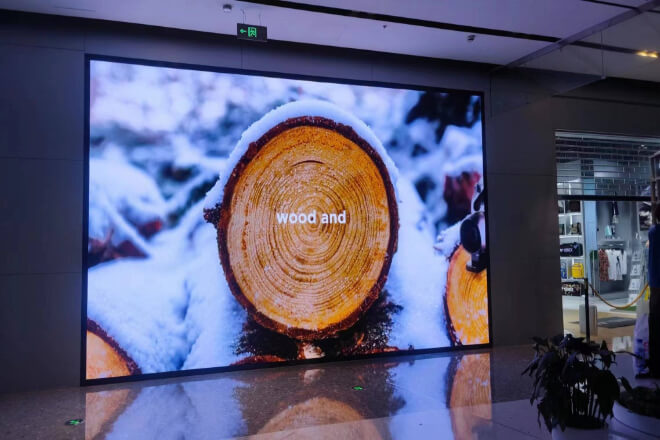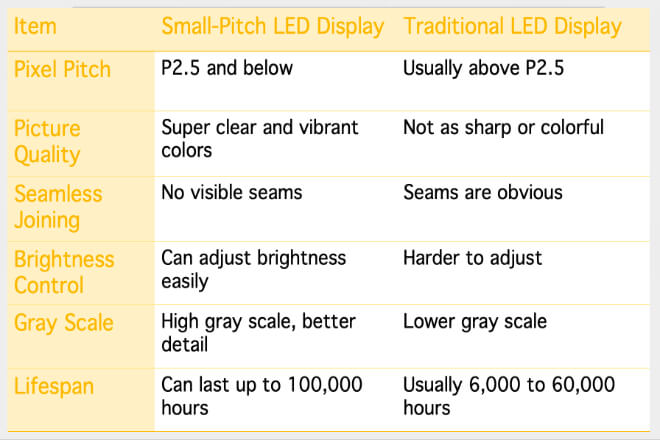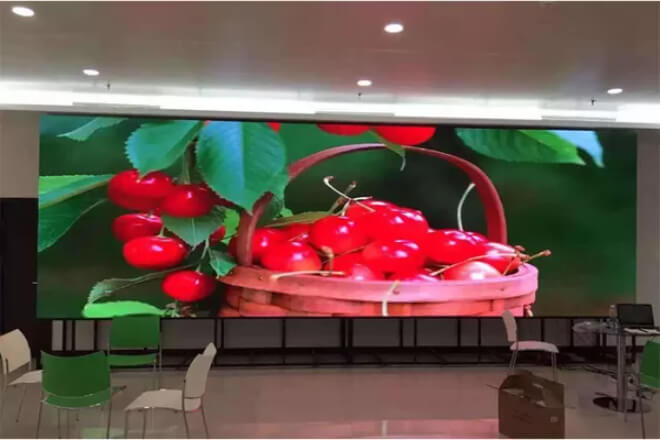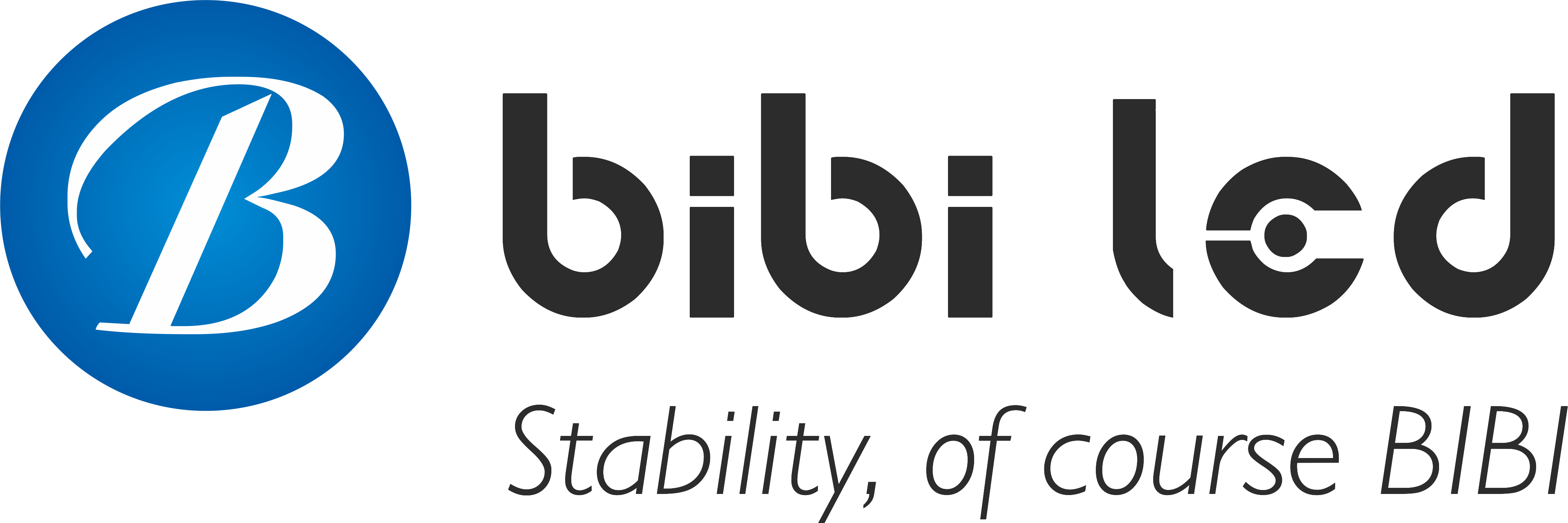介绍

Whether in a conference room, monitoring center, or exhibition hall, a 小间距LED显示屏 is not only a carrier of information but also the key to improving efficiency and attracting attention.
But the question is, do you really need a small-pitch LED display? Is it worth the high cost? This article will reveal the answer for you and help you make a wise choice.
目录
1. What is a small-pitch LED display?
In simple terms, a small-pitch LED display is an LED screen with a very small dot pitch, which is generally P2.5 or below (P2.5 means the distance between pixels is 2.5 mm).
The pixels of this screen are very dense, so the displayed picture is particularly clear and the colors are more vivid.
1). The difference between a small-pitch LED display and a traditional LED display

2). Why are small-pitch LED displays expensive?
The high price of small-pitch LED displays is mainly due to the high technical cost. Specifically:
Lamp bead cost: The more pixels, the more lamp beads, and the cost will naturally go up.
封装技术: To arrange the lamp beads so densely, more advanced packaging technology is needed, such as COB packaging, which increases the cost.
控制系统: Small-pitch LEDs require a more precise control system to adjust the brightness and color of each pixel.
Heat dissipation system: The dense lamp beads generate more heat, and a better heat dissipation system is needed to ensure that the screen does not overheat.
These technical requirements make the manufacturing cost of small-pitch LED displays much higher than that of traditional LED displays, so the price is relatively higher.
2. The core advantages of small-pitch LED screens

The pixels of the small-pitch LED screen are very dense, just like countless small light bulbs arranged tightly together.
This means that the picture is particularly clear, and even if you get very close, you will not see the “large grain” picture, and there is no need to worry about “burning eyes” when watching it at close range.
For example, in a conference room, people sitting in the front row can see it clearly, without worrying about the picture being blurred.
This screen displays colors very accurately and will not be “colored” like some screens. It can restore various colors very well, and the details are very expressive.
For example, when displaying a high-definition photo, even the hair of the person in the photo can be seen clearly, and the color transition is also natural, without the kind of “abrupt” color change.
When the small-pitch LED screen is spliced, there is almost no gap, just like a complete screen.
This is especially useful for places that require a large-screen display (such as command centers and studios).
You can put many small screens together into a super large screen, and the displayed picture is complete and coherent, and the visual effect is particularly shocking.
This screen has a long life and can be used for a long time. It is designed to be very stable, and it will not easily go wrong even if it is used 24 hours a day.
For example, in the scene where it needs to be turned on all the time, it can also work steadily.
In short, the small-pitch LED display is the kind of screen that “looks comfortable and is very reliable to use”, which is especially suitable for places with high requirements for picture quality and display effects.
3. What scenes are suitable for small-pitch LED?
1). High-end conference room
In high-end conference rooms, small-pitch LED display screens are simply “magic weapons”.
During meetings, whether it is displaying high-definition PPT, complex charts, or conducting video conferences, the picture must be clear and detailed, and cannot be blurred.
The pixels of small-pitch LED screens are particularly dense, and there is no graininess when viewed from a close distance, allowing participants to see clearly.
In addition, the light in the conference room is relatively bright during the day, and it is easy to see unclearly if the screen 亮度 is not enough.
But the small-pitch LED screen has high brightness and can automatically adjust according to the light, so there is no need to worry about the picture being glaring or too dark.
This kind of screen can not only make the content of the meeting more professional, but also improve the quality of the entire conference room.
2). Control room (monitoring center, command center)
Places such as control rooms and command centers have particularly high requirements for screens.
Staff need to monitor a large amount of information in real time, and the screen must run 24 hours a day without interruption, and the picture cannot be sloppy at all.
高 解决 and high contrast of the small-pitch LED screen can make complex monitoring pictures appear clearly.
And even the details in the dark can be seen at a glance. Moreover, it can be seamlessly spliced into a super-large screen, which is convenient for staff to view global information.
More importantly, the small-pitch LED screen has a long life and high reliability, so there is no need to worry about frequent problems.
It is particularly suitable for such scenarios that require long-term stable operation.
3). High-definition content display (medical imaging, studio)
In places such as medical imaging and studios where the image quality is extremely high, the advantages of small-pitch LED screens are more obvious.
The small-pitch LED screen has strong color reproduction ability and can accurately display every detail in the image, helping users make more accurate judgments.
In the studio, the picture quality of the background screen directly affects the effect of the program.
The small-pitch LED screen can display high-definition and realistic pictures, making the audience feel immersed and improving the overall effect of the program.
4). Small space, close viewing venues for the audience
For some small spaces, such as small 展览 halls, corporate front desks, classrooms, etc.
The screen space is limited, but the audience is very close to the screen, which puts high demands on the screen’s picture quality.
The advantages of small-pitch LED screens are fully reflected here. Its pixels are very dense, and the picture is still clear and delicate when viewed from close range, and it will not be “blurred” like traditional screens.
Moreover, the brightness and color performance of small-pitch LED screens are excellent.
Which can maximize the display effect of limited space, making them especially suitable for such close-range viewing scenes.
4. Do you really need such high clarity?

In fact, whether a small-pitch LED display is needed depends mainly on the specific application scenario and needs.
You can start from these questions to analyze whether a small-pitch LED display is really suitable for your scene.
The picture quality of the small-pitch LED screen is really great, but if it is only used to display some simple text or not very high-definition content, it is like taking a photo with a high-definition lens, which is a bit wasteful.
If the content you display is already very high-definition, such as high-definition video, complex charts.
Or things like medical imaging that require accuracy to every pixel, then the small-pitch LED screen can play a big role.
A fine pitch LED screen is like a good knife, but if the vegetables it cuts are not fresh, then no matter how good the knife is, it is useless.
If your content itself has a low resolution, such as some blurry pictures or low-quality videos, then the fine pitch LED screen will not show good results, no matter how high-definition it is.
So, don’t just stare at the screen itself; the quality of the content is also critical.
The biggest advantage of a fine pitch LED screen is that the picture will not be blurry even if you look at it from a close distance, if the audience is very close to the screen in your scene.
For example, in a conference room, classroom, or exhibition hall, a fine pitch LED screen is definitely a plus. But if the audience is far away from the screen.
For example, in places like large 体育馆 or outdoor billboards, a normal pitch LED screen may be enough, after all, the audience can’t see the graininess at all.
这 亮度 and contrast of a fine pitch LED screen are very high, so the display effect is particularly good when the indoor light is not too strong.
But if the ambient light is particularly strong, such as direct sunlight outdoors, then LED screens with normal pitch may be more suitable.
Because they are usually designed to be brighter and more suitable for environments that are blindingly bright.
If the content you are displaying is very high-definition, the audience is close to the screen, and the ambient light is not too strong, then a small pitch LED screen is your “hard dish”.
If the content quality is not high, the audience is far away, or the ambient light is particularly strong, then a normal pitch LED screen may be enough.
In short, don’t be dazzled by high-end technology; the key is to look at your actual needs!
5. How do you judge whether your project is "worth" using a small pitch?

1). Return on investment assessment
In short, it is to calculate whether you can earn back or even earn more after spending so much money.
Small pitch LED screens are indeed expensive, but don’t forget that they can be used for a long time and are worry-free to use.
For example, in places such as conference rooms or command centers that are used all the time, it can work stably for many years without repairs in the middle, which saves a lot of money!
If you use it to attract customers and improve your image, the benefits may be higher than the cost you spend.
例如,在 展览 hall, high-definition images can make people shine, attract more attention, and maybe sign a few more orders.
If you calculate and feel that the money you spend can be earned back, then it is worth using a small pitch LED screen.
2). Actual use vs display needs
You must first figure out whether your project pays more attention to actual functions or display effects.
If it is mainly used for monitoring and viewing data, the high-definition picture quality and stability of the small-pitch LED screen can be of great help.
For example, in the monitoring center, the picture is clear, the staff can see the problem at a glance, and the efficiency is directly maximized if you pay more attention to the display effect.
For example, in an exhibition hall or art exhibition, the seamless splicing and high-definition picture of the small-pitch LED screen are simply “eye-catching artifacts”.
The picture seen by the audience is complete and delicate, and the experience is directly maximized.
If your project requires both practical functions and good display effects, then the small-pitch LED screen is your “panacea”.
3). Is it a one-time project or a long-term use scenario
This is also very critical. If the project is only used once, such as a temporary exhibition, it is indeed a bit uneconomical to spend a lot of money to buy a small-pitch LED screen.
In this case, just rent a device or choose a cheaper screen. However, if the project is to be used for a long time.
Such as in a conference room or studio, the advantages of the small-pitch LED screen will come out.
It can be used for a long time, and it always maintains a high-quality picture, which is particularly worry-free to use.
In the long run, it is very cost-effective and is definitely worth investing in.
6. Is there a more suitable alternative?

1). Can P3 or higher LED screens be used as a substitute?
1.1). Scene demand analysis
P3 or higher LED screens are cheap, but if the scene has high requirements for picture quality, such as conference rooms and studios that require high-definition display, then it is not enough.
If you look at the P3 screen from a close distance, the picture will be a bit “blurry” and the graininess will be obvious.
However, if the scene does not require high picture quality, such as a long-distance billboard or temporary display, the P3 screen can still be used.
1.2). Suggestion
If your budget is limited and the scene does not require close viewing, the P3 screen can be considered.
However, if the scene has high requirements for picture quality, it is better not to use the P3 screen, and the small-pitch LED screen is more reliable.
2). Can LCD splicing screens be used as a substitute?
2.1). Scene demand analysis
The LCD splicing screen has good picture quality and high color reproduction, which is suitable for displaying fine content.
But the problem is that the splicing seams are obvious, especially when the large screen is spliced, the picture will be “split”.
Moreover, the brightness is low, and it is not clear in bright places. In contrast, the small-pitch LED screen has high brightness, seamless splicing, and better visual effects.
2.2). Recommendation
If your scene has high color requirements, but the splicing problem is acceptable, and it is mainly used in dark indoor places, an LCD splicing screen can be considered.
However, if the scene requires seamless, high-brightness images, such as conference rooms and studios, LCD splicing screens will not work.
3). Can projection be replaced?
3.1). Scene demand analysis
The clarity and contrast of the projector are worse than those of the small-pitch LED screen, and it is particularly sensitive to ambient light. As long as the light is slightly brighter, the picture will be blurred.
There is no need to worry about this problem with the small-pitch LED screen. It can maintain a clear picture in all environments.
Therefore, the projector is more suitable for temporary display or scenes with low requirements for image quality.
3.2). Recommendation
If your scene is temporary, the ambient light can be fully controlled, and the image quality requirements are not high, the projector can be used.
But if the scene requires high-definition, high-contrast images, such as conference rooms and studios, don’t use projectors. Small-pitch LED screens are a better choice.
4). Summary and suggestions
Small-pitch LED screens are indeed very strong in terms of image quality, brightness, and seamless splicing, and are suitable for scenes with high display requirements.
If the scene is cost-sensitive and does not require high image quality, P3 screens and LCD splicing screens can be considered.
If it is a temporary scene and the ambient light is controllable, projectors can also be used.
But if you want the picture to be high-definition, seamless, and good-looking in various environments, choose a small-pitch LED screen!
七、结论
The small-pitch LED display is undoubtedly the leader in current display technology, but whether it is suitable for your project also needs to consider the actual needs, budget, and usage scenarios.
I hope this article can help you better understand the advantages and limitations of small-pitch LED displays.
最后,如果您想了解更多关于LED显示屏的知识, 请与我们联系。
